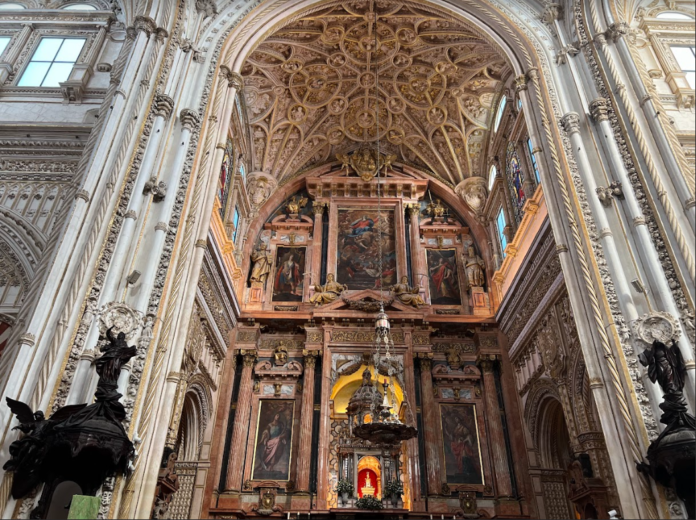Written by Emaan Nizami
Embarking on a trip through Granada, Córdoba, and Seville in Spain isn’t just about sightseeing—it’s about stepping into a world of Islamic heritage where Muslims, Jews and Christians thrived and prospered in peaceful coexistence. These cities still bear the marks of their rich Islamic heritage, making for a captivating journey through time.
In November, my family and I set on an adventure to Spain. Curious about the reason behind our choice of destination, I asked my parents why they had selected Spain out of all the places we could have visited. Their response was enlightening: they explained that they chose Spain with the intention of delving into its Islamic legacy, seeking to broaden our understanding of its cultural diversity and history.
During our journey, we explored four charming cities in Spain: Madrid, Cordoba, Granada, and Seville, before returning to Madrid. Each stop offered a unique opportunity to uncover the Islamic heritage deeply rooted within Spain’s history.
As I stepped into the heart of Cordoba, I was instantly swept away by the blend of Islamic and Christian influences that define this enchanting city. The whispers of its Al-Andalus past lingered in every corner, guiding me through its winding streets decorated with whitewashed buildings that seemed to shimmer under the sun. The Mosque-Cathedral stood as a statement to Cordoba’s rich history, showcasing its rich architectural styles. Every pillar presented a different and intricate design, and I couldn’t help but wonder about the story behind each one. As I wandered through its sacred halls, I could feel the weight of centuries past, each pillar telling a story of conquest and coexistence.
Mosque Section Of Mosque-Cathedral
Cathedral Section of Mosque-Cathedral
Prince Faisal of “Lawrence of Arabia” said of the city, “You know, Lieutenant, in the Arab city of Córdoba there were two miles of public lighting in the streets when London was a village.” These words echoed in my mind as I explored the city, imagining the bustling streets illuminated by the soft glow of lanterns centuries ago. The old quarter with its narrow alleys and hidden courtyards, each step revealing a new layer of Cordoba’s vibrant culture while the scent of spices hung in the air. Cordoba is a magnificent city filled with the utmost amount of history.
Hidden Restaurant in Cordoba
Leaving behind the charm of Cordoba, we headed towards Granada. Excited for new adventures, we looked forward to exploring another beautiful Spanish city.
Granada’s Islamic influence is striking, particularly evident in the breathtaking Alhambra Palace. The Nazrid Dynasty in Granada, founded in the 13th century, was a time of great Islamic influence in Spain. Rulers like Yusuf I and Muhammad V promoted culture and art, as seen best in the city’s palace and citadel complex..
The Alhambra Palace is not only renowned for its stunning architecture but also for its intricate system of man-made waterways, which contribute to the palace’s beauty and functionality. These water features, known as “acequias” in Spanish, are a testament to the ingenuity of Muslim engineers who designed them centuries ago.
The acequias in the Alhambra serve multiple purposes, ranging from irrigation to providing decorative and aesthetic elements, reflecting the importance of water in Islamic culture. The waterways draw from nearby natural sources, most importantly the Darro River.
Intricate designs in Alhambra
Alhambra at night
As I explored the palace I took note of all the intricate designs. In every room and wall I could see a different pattern. Walking through its corridors and gardens, I felt transported to another time, marveling at the beautiful calligraphic designs and the peaceful atmosphere. The Albayzín neighborhood further immersed me in this heritage, with its winding streets and charming white buildings.
Exploring Granada’s streets, I encountered former mosques transformed into churches and stumbled upon cozy tea houses, each offering a unique glimpse into the city’s Islamic past. The vibrant markets burst with colors and aromas, while the sounds of Andalusian music and dance performances filled the air. And let’s not forget the food – every bite felt like a journey through time, reflecting the enduring influence of Islamic traditions on Granada’s culinary delights. Overall, my time in Granada was a captivating journey into a world where history, culture, and flavor intertwined.
Our next destination was Seville. Anticipating new experiences, we eagerly continued our road trip through Spain.
Upon arriving and wandering through Seville, the Alcázar Gardens drew me into a world of enchantment. The gardens’ lush greenery and vibrant blooms created a colorful tapestry against the backdrop of ancient walls. It was like walking through a dream, where every turn revealed a new burst of beauty. Amidst the tranquil ponds and fragrant orange trees, I felt transported to a time when the gardens were a sanctuary for sultans and poets. Here, I thought to myself, the Islamic influence is alive and thriving, adding a touch of magic to an already mesmerizing cityscape.
Alcazar Gardens
In summary, my journey across Spain was full of surprises. From the narrow streets in Cordoba to giant palaces in Granada, I saw sights I had never seen before. Stumbling upon landmarks like the Alhambra and the Mosque-Cathedral was truly remarkable. These discoveries shed light on Spain’s diverse history and the lasting impact of Islamic culture on its heritage. Oh, and I may have already mentioned this but, the food in Spain is absolutely delicious – from the hummus to the chicken wings and everything in between!
- Emaan Nizami


